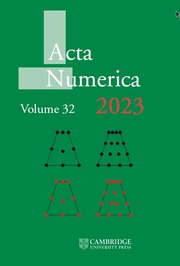Article contents
Acceleration methods for fixed-point iterations
Published online by Cambridge University Press: 01 July 2025
Abstract
A pervasive approach in scientific computing is to express the solution to a given problem as the limit of a sequence of vectors or other mathematical objects. In many situations these sequences are generated by slowly converging iterative procedures, and this led practitioners to seek faster alternatives to reach the limit. ‘Acceleration techniques’ comprise a broad array of methods specifically designed with this goal in mind. They started as a means of improving the convergence of general scalar sequences by various forms of ‘extrapolation to the limit’, i.e. by extrapolating the most recent iterates to the limit via linear combinations. Extrapolation methods of this type, the best-known of which is Aitken’s delta-squared process, require only the sequence of vectors as input.
However, limiting methods to use only the iterates is too restrictive. Accelerating sequences generated by fixed-point iterations by utilizing both the iterates and the fixed-point mapping itself has proved highly successful across various areas of physics. A notable example of these fixed-point accelerators (FP-accelerators) is a method developed by Donald Anderson in 1965 and now widely known as Anderson acceleration (AA). Furthermore, quasi-Newton and inexact Newton methods can also be placed in this category since they can be invoked to find limits of fixed-point iteration sequences by employing exactly the same ingredients as those of the FP-accelerators.
This paper presents an overview of these methods – with an emphasis on those, such as AA, that are geared toward accelerating fixed-point iterations. We will navigate through existing variants of accelerators, their implementations and their applications, to unravel the close connections between them. These connections were often not recognized by the originators of certain methods, who sometimes stumbled on slight variations of already established ideas. Furthermore, even though new accelerators were invented in different corners of science, the underlying principles behind them are strikingly similar or identical.
The plan of this article will approximately follow the historical trajectory of extrapolation and acceleration methods, beginning with a brief description of extrapolation ideas, followed by the special case of linear systems, the application to self-consistent field (SCF) iterations, and a detailed view of Anderson acceleration. The last part of the paper is concerned with more recent developments, including theoretical aspects, and a few thoughts on accelerating machine learning algorithms.
Information
- Type
- Research Article
- Information
- Creative Commons
- This is an Open Access article, distributed under the terms of the Creative Commons Attribution licence (http://creativecommons.org/licenses/by/4.0/), which permits unrestricted re-use, distribution, and reproduction in any medium, provided the original work is properly cited.
- Copyright
- © The Author(s), 2025. Published by Cambridge University Press
References
- 1
- Cited by

